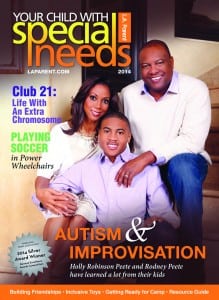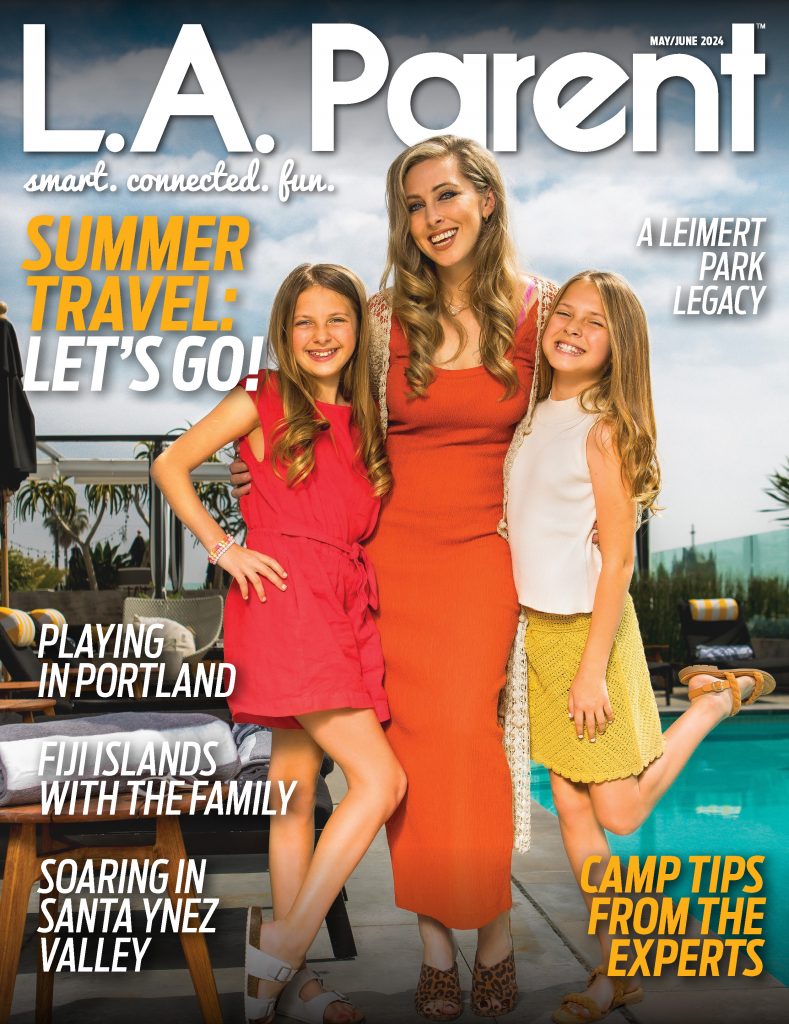Parents can help smooth interactions – and build friendships – between typical children and those with special needs
By Lori Lakin Hutcherson
Look at me! Why don’t you talk to me? What’s the matter with you? Do you have cancer?!
“A young girl stopped my son and started screaming at him,” says Monica Jones, describing an incident at the park with her 7-year-old son Henry, who was born with Hemimegalencephaly, a non-genetic condition where one side of the brain is abnormally larger than the other. Henry is non-verbal, and his behavior can be similar to that of someone with autism, including repetitive actions such as humming, flapping and walking in circles.
“The mom was on the phone and didn’t stop her daughter, just seemed to be totally oblivious,” continues Jones, co-founder of the Brain Recovery Project in Pasadena. “My husband was not oblivious and proceeded to let the mom have it. It was a sad moment for him to see another child do that to our older son.”
This type of interaction between typical children and kids with special needs is, unfortunately, all too common. My son Xavier, a first grader who gets around in a wheelchair because of challenges due to cerebral palsy, epilepsy and dystonia, hasn’t been screamed at but is often stared at in stores, at the park or at birthday parties.
Sometimes, he even receives fearful glances or full-on eye aversions. Like other children with disabilities, he is often ignored or spoken over as if he can’t respond or understand, or as if he isn’t even there. While most kids’ curiosity is harmless and vastly more welcome than avoidance, it saddens me when people bluntly ask, “Why is he in a wheelchair?” or “Why is he drooling?” without even introducing themselves or saying hello first.
 A Good Start
A Good Start
As parents, it’s up to us to facilitate kind, respectful, and friendship-building interactions between typical and special-needs children. We can begin by assuming that people with disabilities can, and want to, interact with us. “Never underestimate their capabilities. Look at them as a whole individual,” advises Keely Arevalo, a special-education teacher at CHIME Charter School in Woodland Hills. Speak to the person – with their parent or caretaker – not about the person, Arevalo adds.
Modeling good conversation, Arevalo offers, is another major way parents can help. “Maybe say ‘Hey, how are you? How’s your day? It looks like you have a Harry Potter book. Did you read it?’ And even if the individual didn’t respond, that’s OK. Let your child see a good way to interact in those situations.”
Amanda Hsu, a case supervisor at Working With Autism in Encino, suggests finding similarities to create positive exchanges. “Let your child know that, just like they have things they like or don’t like, kids with disabilities have those same things,” Hsu says. “Finding common ground is a good starting point to focus on instead of focusing on the differences.”
Teaching respectful curiosity is another important thing parents can do, according to Fred Johnson, whose 15-year-old son Ulysses has Down syndrome. He advises parents to let their children know that it is OK to ask questions – within limits. “Role play with your kids,” he says, suggesting that you ask a question your child finds embarrassing, then ask how that makes them feel. “You don’t ask anything of someone you wouldn’t be ready to answer yourself,” is his rule.
Be Prepared
This kind of preparation helped Arevalo’s 5-year-old niece have a successful visit to her classroom. “I told her, ‘Every person is different, every person has different needs, different abilities, different strengths and weaknesses. Despite those things, we’re all human beings, we all deserve to be treated fairly,’” Arevalo says.
Arevalo also taught her niece how to ask questions in an appropriate way.
“She did have questions and she did pull me to the side at an appropriate time,” Arevalo says. “The rest of the afternoon, she actually was gravitating towards the individuals with disabilities and wanted to sit with them and play with them. My niece looked past the disability and saw an individual.”
If you notice that your child is uncomfortable around people with disabilities, reassure them and encourage them to talk with you about it so that you can help. “Let them know it’s OK to have fears,” advises Arevalo. “Guide that conversation and say, ‘I noticed you looked a little bit uncomfortable’ to find out exactly what they were afraid of. A lot of times those fears will go away once there isn’t that unknown.”
Make your explanations age-appropriate. “For a 5-year-old, you want to explain it as simply as you can,” Hsu offers. “For example, ‘Maybe the little boy is in the wheelchair because he’s not able to walk, so the wheelchair is a thing that helps him move around just like you and I move around with our legs.’”
Taking the Lead
If your child becomes frustrated in trying to make friends with, or be a friend to, a child with special needs, remind them that friendship isn’t always easy. “Interacting or playing with your friends, sometimes that’s a difficult thing for some kids,” says Hsu. “Have your child come up with some ideas as how to engage that child.” You can help lead the way with questions such as, “What is your friend like?” and, “What do you think you could do to make her more comfortable?”
Parents can help by reaching out, too. “Sometimes it starts with the moms becoming friends,” says Jones. “That’s how you open up the friendship with the kids.”
For typical children, extending themselves to peers with disabilities is well worth the effort. “There’s a sense of, ‘I did something good,’” says Hsu. “It’s a two-way thing that’s a good lesson for both [the typical and the special-needs child].”
“Bring special-needs children to your parties. Ask for play dates after school, even if they’re wheelchair-bound and tube-fed and can’t talk,” urges Jones. “I wish every parent reading this article who has only typically developing kids would assess if their child has a friend with special needs. If they don’t, tell them to make one, and incorporate that child into your lives. If every typically developing child had one friend with significant special needs, then what a beautiful world we’d live in.”
Lori Lakin Hutcherson is a film and television writer/producer, editor of the award-winning website, goodblacknews.org, and mother to Xavier, one of the coolest kids in the world, who also happens to have special needs.
Building Bridges Between Typical and Special-Needs Kids
Model appropriate behavior. Greet people and ask respectful questions, so your children see how to do it.
Find common ground. Focus on similarities instead of differences.
Be inclusive. Invite special-needs children to a party, to play or join a group.
Assume ability. Always assume the child with disabilities understands you. Speak directly to that child and include them in conversations with parents or caregivers.
Open communication. Let your child know it’s OK to have fears and ask questions.
Don’t ask “What’s wrong with you?” or any question in a way that might hurt feelings.
Don’t exclude. Don’t assume a child with disabilities can’t handle a situation or activity. Let the child and the child’s family decide.
Don’t look away or avoid individuals with disabilities. Smile!
Don’t patronize. Most kids with disabilities like the same things their peers do.
Don’t touch without permission. Ask first!
Don’t pull your child away if they say something embarrassing. Use the incident as a teachable moment.
 Extra-Special Publication
Extra-Special Publication
The 2014 edition of Your Child With Special Needs, from your trusted friends at L.A. Parent, is now available. We launched this new venture in April 2013 and – after tremendous response from the parenting community – are excited to bring you the sequel.
This is especially true since the 2013 edition received recognition from the Parenting Media Association, taking home a bronze award for cover design and a silver award for general excellence at the association’s annual convention in February.
On the cover of Your Child With Special Needs 2014, actress Holly Robinson Peete and former NFL quarterback Rodney Peete pose with their son RJ, who has autism. And an article inside features the couple’s advice about keeping a relationship strong while coping with the care of a special-needs child. Additional features cover:
The atypical parenting needs of atypical kids,
Pasadena’s Club 21 and its services for families coping with Down syndrome,
The latest inclusive toys,
Keys to a positive summer-camp experience, and
Organizations that help foster friendships between kids with special needs and their typical peers.
We wrap up the book with a helpful resource section designed to connect families with everything from camps to legal services, recreation, schools, therapy and treatment centers. Other fun additions include an interview with the captain of a power (wheelchair) soccer team, book reviews, and tips for visiting museums with kids with special needs
Can’t find a copy? You can read it online at LAParent.com, or call us at 818-264-2222 and someone in the office will give you a hand in locating one. Got a story idea on a special-needs topic, or news of a special-needs event? Email it to Christina.Elston@laparent.com.





























